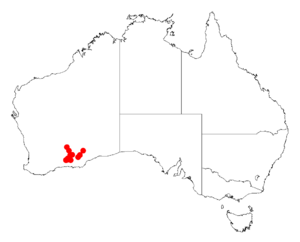Acacia inamabilis facts for kids
Quick facts for kids Acacia inamabilis |
|
|---|---|
| Scientific classification | |
| Genus: |
Acacia
|
| Species: |
inamabilis
|
 |
|
| Occurrence data from AVH | |
Acacia inamabilis is a type of shrub that belongs to the Acacia family. It is found naturally in Western Australia. This plant is also known as a wattle, which is a common name for many Acacia species.
What is Acacia inamabilis like?
This shrub spreads out and has a strong smell. It usually grows to be about 0.2 to 1.3 metres (0.7 to 4.3 ft) tall. Its branches are strong and green, with thin yellow lines. They are mostly smooth (meaning they don't have hairs).
The plant has sharp, straight parts called stipules, which are like small leaf-like structures at the base of the leaf stalk. These stipules are about 2.5 to 5 mm (0.098 to 0.197 in) long. The leaves, called phyllodes, are stiff, green, and have a sharp point. They can be straight or slightly curved.
These phyllodes are special because they are shaped like a five-sided stick when you look at them from the end. They are about 20 to 45 mm (0.79 to 1.77 in) long and around 1.5 mm (0.059 in) thick. Acacia inamabilis produces bright yellow flowers. You can usually see these flowers between August and September.
How was Acacia inamabilis named?
A botanist named Ernst Georg Pritzel first officially described this plant in 1904. He did this as part of a big project with another botanist, Ludwig Diels. Their work was published in a science journal called Botanische Jahrbücher für Systematik, Pflanzengeschichte und Pflanzengeographie.
For a short time in 2003, the plant was given a different scientific name, Racosperma inamabile, by Leslie Pedley. However, in 2006, it was moved back to its original genus, Acacia.
A. inamabilis is very similar to another plant called Acacia concolorans. Sometimes, people might even confuse it with Acacia calcarata.
Where does Acacia inamabilis grow?
You can find Acacia inamabilis spread out in different spots across the Goldfields-Esperance region of Western Australia. It grows from places like Mount Malcolm in the east, past Norseman in the west, and down south near Peak Charles National Park.
This plant often grows near large granite rocks and rocky areas. It also likes to grow near salt lakes. You'll usually find it in sandy or loamy soils. It's often part of open forests where Eucalyptus trees grow, or in areas with mallee plants, which are a type of shrubby eucalyptus.

